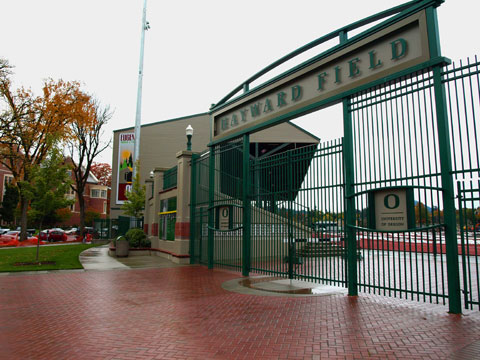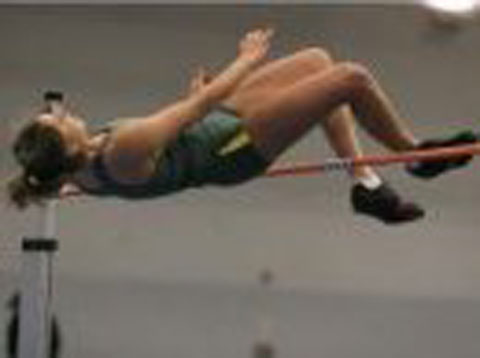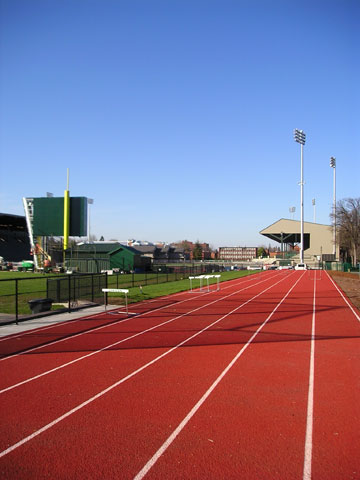A living legacyHayward Field has played host to thousands of athletes over the last century. Memories of great performances and experiences linger long after athletes have left the field.
By Sydney SmeedWhen Hayward Field was built nearly a century ago, odds are those who broke ground at 15th and Agate Street had no idea the impact that the facility would have on Eugene and the track and field community in the future. Hayward Field has offered University of Oregon and athletes and their fans a place to dig their cleats in, exercise talents and leave everything they have on the field. Hayward Field opened in 1919 as the university’s football field. Two years later, it opened its gates to track and field athletes as well. The facility continues to evolve from its original state to better serve track and field athletes of the 21st century. Special Olympians, high school and middle school athletes and world-class stars have sprinted, thrown and jumped their way across Hayward Field. The impact of Hayward, the University of Oregon track team and the legacy of track and field in Eugene is one that designers in the early 1900s could never have foreseen. Hayward Field was named for the men’s first track coach, Bill Hayward, and originally had a six-lane track surrounding the football field. According to the University of Oregon’s athletic Web site and other track and field sources, in the late 1960s, the University of Oregon football team no longer fit into the facility and moved across the river to Autzen Stadium. After the departure of the football team, the track was upgraded to eight lanes. Bleachers were rebuilt, and a scoreboard showing times was added to the facility. In 1988, the track made the switch to 400 meters from 440 yards. Perhaps the most extensive design change to the facility, the change took away the sharp corners of the track and brought the track up to date in the metric system. Now, Hayward Field is getting one more facelift. Construction trucks, workers and noises are nothing new to UO students. However, this most recent construction was more than just a campus renovation. After Hayward Field was named the site of the 2008 Olympic Trials, the facili ty found itself amidst its latest renovation. Permanent lighting has been added, the infield has been gutted and redesigned, a brand-new scoreboard is replacing the original and boasts a video screen to boot, which University of Oregon heptathlete Kalindra McFadden describes as “awesome.” The new scoreboard will show live results and live video feed of the races. The northeast entrance has been revamped as well to welcome track enthusiasts into one of the most well know track venues around. The new entrance features a mural and timeline of Oregon Track. Athletes have not been allowed on the field yet, and McFadden eagerly awaits her chance to try out the new high jump pit on the newly leveled infield.  McFadden has been at the University of Oregon since 2004 when she joined the track team. Not a stranger to Hayward Field, McFadden based her decision to go to Oregon heavily on the fact that her father ran track for Oregon and, she said, “because of the history and background of track. Also, we have some of the best coaches and athletes in the nation, so it’s amazing to be able to interact with them on a daily basis.” “Having the Olympic Trials will expose Eugene and Oregon Track to the entire world. I feel that it will bring back the same excitement that was here when Pre was here and expose the history and future of track and field at Oregon.”The Olympic Trials are returning to the only venue ever to host them three times in a row. Perhaps another run is in the cards for Hayward Field, since the Olympic Trials committee announced that Eugene would be the location for the 2012 Trials as well. McFadden is eagerly awaiting the arrival of the Trials. “Having the Olympic Trials will expose Eugene and Oregon Track to the entire world," she said. " I feel that it will bring back the same excitement that was here when Pre was here and expose the history and future of track and field at Oregon.” Organizers of the Trials estimate that the 10-day event in June and July of 2008 will bring nearly $28 million to the Eugene area In the 1970s, track superstar Steve Prefontaine brought fans to Hayward Field and became a local celebrity. After his career and death in Eugene, Prefontaine continues to have a hold on the local track community. An annual track meet is held in his honor and T-shirts with “Stop Pre” printed on them sell out every year. Athletes vary from year to year, but fan favorite and world-class 800-meter runner Maria Mutola runs and wins the 800 every year. Michael Johnson and Maurice Greene also have battled it out on the track in the 200, all in the name of the man who truly gave it everything he had each time he raced. “As an athlete here, I find it inspiring that we compete and practice on the same track that he once did,” McFadden said of Prefontaine.  For some fans, there is no greater vantage point than any of Hayward Field’s stands. “[Hayward Field] is the best place for track in the world. It doesn’t matter if it’s an Oregon runner or someone else, the crowd roots on superior performances and athletes,” local businessmen Glenn Smeed says. “The key element at Hayward Field will always be the people in the stands and the athletes that are performing there, and the connection that exists between the two. That’s the signature piece of Hayward Field,” Assistant Athletic Director Mike Reilly told the Register Guard. It is known for the legacies and great athletes that have competed inside its gates. Renovations might keep up with modern technology and growing capacity needs, but the essential aura and feel of Hayward remains the same. Heptathlete McFadden said, “After competing at other tracks, I’ve found that Hayward is one of a kind. The set up allows for tons of fans and it’s a totally different feeling competing in front of your home crowd.” Slideshow of Hayward Field |
